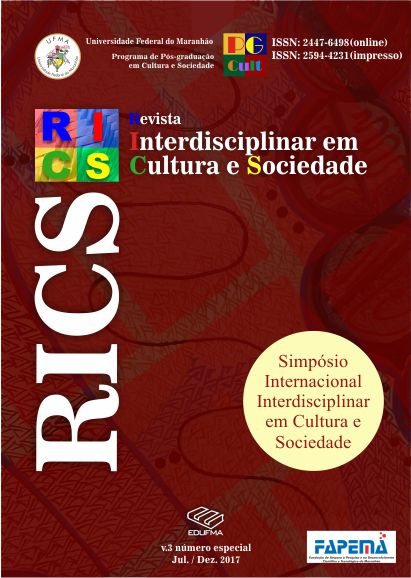ANÁLISE JUNGUIANA DA DUPLICIDADE EM A MORTALHA DE ALZIRA, DE ALUÍSIO AZEVEDO
Palabras clave:
Duplo. Literatura Fantástica. Sombra. Arquétipo.Resumen
A temática relacionada à duplicidade sempre esteve presente na história da evolução da cultura humana, muitas vezes para a explicação de vários aspectos da vivência em sociedade e sua origem, através de mitos e lendas, por exemplo. A mitologia tornou-se elemento para a construção do conhecimento e das artes, como a literatura, que por vezes apresenta as problemáticas relacionadas à psicologia humana. Na literatura fantástica, o duplo configura-se como um dos elementos que provocam a hesitação no leitor, representando aspectos duais da psique humana, sob as dicotomias bem/mal, físico/espiritual, sonho/realidade, consciente/inconsciente. O presente trabalho, que tem como objeto de análise a obra fantástica A Mortalha de Alzira de Aluísio Azevedo, utiliza-se da hipótese dos arquétipos do psiquiatra suíço Carl Gustav Jung para analisar as imagens arquetípicas utilizadas na construção da personagem Ângelo. Como resultado, encontrou-se que Ângelo projeta sua inconsciência no Ângelo boêmio, que corresponderá a seu duplo negativo e Sombra: a manifestação do que condiz ao inconsciente pessoal, representando sentimentos e pensamentos por ele reprimidos na tentativa de manter-se de acordo com os padrões e normas que lhe são impostas.
Palavras-chave: Duplo. Literatura Fantástica. Sombra. Arquétipo.
JUNGIAN ANALYSIS OF DUPLICITY IN A MORTALHA DE ALZIRA, BY ALUISIO AZEVEDO
ABSTRACT: The theme related to duplicity has always been present in the history of the evolution of human culture, often for the explanation of various aspects of the experience in society and its origin, through myths and legends, for instance. Mythology has become an element for the construction of knowledge and the arts, such as literature, which sometimes presents the problems related to human psychology. In fantastic literature, the double appears as one of the elements that provoke the hesitation in the reader, representing dual aspects of the human psyche, under the dichotomies good/evil, physical/ spiritual, dream/reality, conscious/unconscious. The present work, which has as an object of analysis the fantastic work A Mortalha de Alzira by Aluísio Azevedo, uses the hypothesis of the archetypes by the Swiss psychiatrist Carl Gustav Jung to analyze the archetypal images used in the construction of the character named Angelo. As a result, it was found that Angelo projects his unconsciousness into the bohemian Angelo, which will correspond to his negative double and Shadow: the manifestation
of what conforms to the personal unconscious, representing feelings and thoughts he repressed in an attempt to keep up with the standards and norms imposed on it.
Keywords: Double. Fantastic literature. Shadow. Archetype.
Descargas
Descargas
Publicado
Cómo citar
Número
Sección
Licencia

Este trabalho está licenciado com uma Licença Creative Commons Atribuição 4.0 Internacional.


















